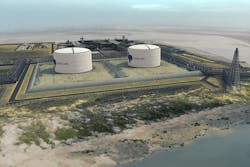More liquified natural gas (LNG) capacity is coming to the U.S. coastline along the Gulf of Mexico.
The Federal Energy Regulatory Commission has re-issued its final order authorizing construction of the Texas LNG export terminal project. An affiliate of energy infrastructure developer Glenfarne is planning the site which is expected to be completed by 2029.
Texas LNG will be located at the Port of Brownsville, Texas, near the mouth of the Rio Grande. Glenfarne and its Texas LNG Brownsville affiliate have locked up customer offtake agreements for exported LNG which, along with the expedited FERC approval, should help to justify a positive final investment decision.
The liquefaction and export terminals are designed to handle 4 million metric tons per year.
“Our world-class partners bring tremendous expertise to this project,” Glenfarne CEO and founder Brendan Duval said in a statement. “The (presidential) administration’s common-sense energy policies and the hard work of the FERC commissioners and staff, and the Texas congressional delegation are helping us unlock the project’s many benefits.”
President Trump and his energy regulatory agencies are making natural gas and baseload power resources a priority for future power projects to meet growing data center and artificial intelligence load. His executive orders and key permitting decisions by the Departments of Energy and Interior are designed to fast-track both gas and future nuclear projects, while ending incentives for renewable energy through the recently signed Republican-formed federal budget.
Engineering, procurement and construction firm Kiewit will lead work on Texas LNG. Once completed and operational, the project will push Glenfarne’s total LNG portfolio to more than 30 million metric tons of exporting product per year.
LNG export terminals along the U.S. coast take in domestic natural gas, mostly from shale plays, and chill it until the gas is liquified and made stable for ocean shipping. Countries and energy off-takers from around the world are signing deals for U.S. LNG, elevating the nation into the top spot for global LNG export volumes.
Eight large-scale LNG infrastructure projects are operational along the nation’s coastlines and could eventually total export capacity of 13.8 billion cubic feet per day, according to U.S. Department of Energy reports.
About the Author
EnergyTech Staff
Rod Walton is senior editor for EnergyTech.com. He has spent 17 years covering the energy industry as a newspaper and trade journalist.
Walton formerly was energy writer and business editor at the Tulsa World. Later, he spent six years covering the electricity power sector for Pennwell and Clarion Events. He joined Endeavor and EnergyTech in November 2021.
He can be reached at [email protected].
EnergyTech is focused on the mission critical and large-scale energy users and their sustainability and resiliency goals. These include the commercial and industrial sectors, as well as the military, universities, data centers and microgrids.
Many large-scale energy users such as Fortune 500 companies, and mission-critical users such as military bases, universities, healthcare facilities, public safety and data centers, shifting their energy priorities to reach net-zero carbon goals within the coming decades. These include plans for renewable energy power purchase agreements, but also on-site resiliency projects such as microgrids, combined heat and power, rooftop solar, energy storage, digitalization and building efficiency upgrades.
